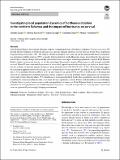Files in this item
Investigating local population dynamics of bottlenose dolphins in the northern Bahamas and the impact of hurricanes on survival
Item metadata
| dc.contributor.author | Coxon, Jennifer | |
| dc.contributor.author | Arso Civil, Monica | |
| dc.contributor.author | Claridge, Diane | |
| dc.contributor.author | Dunn, Charlotte | |
| dc.contributor.author | Hammond, Philip S. | |
| dc.date.accessioned | 2022-09-27T11:30:03Z | |
| dc.date.available | 2022-09-27T11:30:03Z | |
| dc.date.issued | 2022-09-19 | |
| dc.identifier | 277341145 | |
| dc.identifier | 4c99acd5-5086-437e-af78-eb245cd12412 | |
| dc.identifier | 85133182894 | |
| dc.identifier | 000855800000001 | |
| dc.identifier.citation | Coxon , J , Arso Civil , M , Claridge , D , Dunn , C & Hammond , P S 2022 , ' Investigating local population dynamics of bottlenose dolphins in the northern Bahamas and the impact of hurricanes on survival ' , Mammalian Biology , vol. Online First . https://doi.org/10.1007/s42991-021-00208-0 | en |
| dc.identifier.issn | 1618-1476 | |
| dc.identifier.other | ORCID: /0000-0001-8239-9526/work/119628518 | |
| dc.identifier.other | ORCID: /0000-0002-2381-8302/work/119628720 | |
| dc.identifier.other | ORCID: /0000-0002-4274-7239/work/119628785 | |
| dc.identifier.uri | https://hdl.handle.net/10023/26075 | |
| dc.description | This study was made possible with financial support from Earthwatch Institute, Atlantis Blue Project Foundation, with permission to conduct research granted by the Bahamas Department of Marine Resources. | en |
| dc.description.abstract | Little Bahama Bank in the northern Bahamas supports several populations of bottlenose dolphins (Tursiops truncatus). We provide the first estimates of birth rate and age-class-specific apparent survival rates for the local South Abaco population using data from a long-term (1997–2014) photo-identification (photo-ID) study and use the estimated life history parameters in a population viability analysis (PVA) to predict future population trends. Hurricane events are predicted to become more intense due to climate change but knowledge of how hurricanes may impact cetacean populations is limited. Little Bahama Bank is subject to hurricane activity, so we also investigate the potential impact of hurricanes on calf, juvenile and adult survival. Photo-ID data confirmed the existence of a core adult population with relatively high site fidelity in South Abaco, but also evidence of transient animals. Estimated annual birth rate was 0.278 (95% CI: 0.241–0.337). We found strong support for a decline in apparent survival for all age-classes. Estimated survival declined by 9% in adults (0.941 in 1998, to 0.855 in 2013), 5% in juveniles (0.820 in 2000, to 0.767 in 2013) and 36% in calves (0.970 in 1997, to 0.606 in 2013). Evidence that survival was influenced by repeated hurricane activity leading to increased mortality and/or emigration was stronger for calves and juveniles than for adults. PVA simulations of an assumed isolated South Abaco population showed that declines would lead to extinction within decades, even under the most optimistic scenario. Future work should focus on establishing if South Abaco is part of natural source–sink metapopulation dynamics on Little Bahama Bank by assessing trends in abundance in local populations and establishing how they interact; this will be important for assessing their conservation status in a potentially increasingly changing environment. | |
| dc.format.extent | 16 | |
| dc.format.extent | 2555596 | |
| dc.language.iso | eng | |
| dc.relation.ispartof | Mammalian Biology | en |
| dc.subject | Birth rate | en |
| dc.subject | Bottlenose dolphin | en |
| dc.subject | Hurricane | en |
| dc.subject | Little Baham Bank | en |
| dc.subject | Mark-recapture | en |
| dc.subject | Photo-identification | en |
| dc.subject | Population decline | en |
| dc.subject | Population viability analysis | en |
| dc.subject | Survival | en |
| dc.subject | Tursiops truncatus | en |
| dc.subject | GC Oceanography | en |
| dc.subject | QH301 Biology | en |
| dc.subject | NDAS | en |
| dc.subject | SDG 10 - Reduced Inequalities | en |
| dc.subject | SDG 13 - Climate Action | en |
| dc.subject.lcc | GC | en |
| dc.subject.lcc | QH301 | en |
| dc.title | Investigating local population dynamics of bottlenose dolphins in the northern Bahamas and the impact of hurricanes on survival | en |
| dc.type | Journal article | en |
| dc.contributor.institution | University of St Andrews. Sea Mammal Research Unit | en |
| dc.contributor.institution | University of St Andrews. School of Biology | en |
| dc.contributor.institution | University of St Andrews. Marine Alliance for Science & Technology Scotland | en |
| dc.contributor.institution | University of St Andrews. Scottish Oceans Institute | en |
| dc.contributor.institution | University of St Andrews. Centre for Research into Ecological & Environmental Modelling | en |
| dc.identifier.doi | https://doi.org/10.1007/s42991-021-00208-0 | |
| dc.description.status | Peer reviewed | en |
This item appears in the following Collection(s)
Items in the St Andrews Research Repository are protected by copyright, with all rights reserved, unless otherwise indicated.

